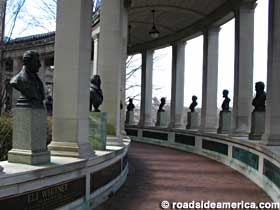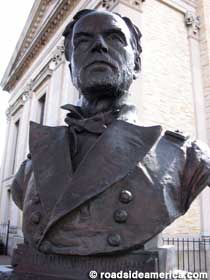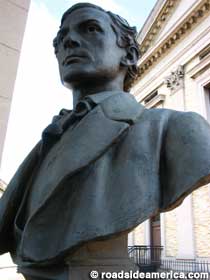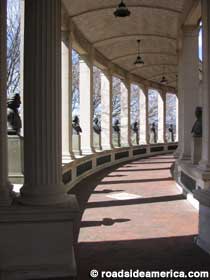
The Great Americans.
Hall of Fame for Great Americans
Bronx, New York
We have halls of fame for every activity and occupation nowadays -- from the RV industry, to exotic dancers, to freshwater fishing. It's hard to imagine a time when the concept was daring and new. But there had to be a first -- and in America the first was The Hall of Fame for Great Americans.
It was conceived in an era when fame had not yet morphed into celebrity, when its gates had not yet been thrown open to the masses -- to glorify whomever and whatever they wanted.

William Tecumseh Sherman
The Hall of Fame for Great Americans was administered by New York University and housed at its Bronx campus. When it opened on May 30, 1901, it was considered to be an important and educational attraction. Visitors would take day trips to its panoramic spot atop one of the highest points in New York City -- a bluff overlooking the Harlem River, the same heights from which the British drove the Americans out of New York during the Revolutionary War. NYU Chancellor Henry MacCracken thought that it was delicious irony to use this spot as a pantheon to honor great Americans.
The Hall, designed by big-deal architect Stanford White, is a breezy neo-classical colonnade with a vaulted ceiling, wrapped around the back of two college halls and a library. Bronze busts of the honorees line the low walls on either side. Beneath them are large bronze tablets, originally designed by the Tiffany Studios, providing the person's name, years of birth and death, and some noble quote associated with him or her -- but no information about who they were, or why they were so great. The well-heeled visitors of the early 20th century didn't need to be told that, for example, Elias Howe patented the sewing machine, or that Lewis Agassiz came up with the idea of the Ice Age. But today's visitors are at a loss, something that the founders of this Hall never foresaw.

Edwin Booth, brother of Lincoln's assassin.
The Hall would induct new worthies every five years. Some of them are people that you'd expect to see: George Washington, Thomas Edison, Abraham Lincoln. But obscure names are here as well -- people such as James Eads, who designed armored steamboats; William Morton, who fraudulently claimed to have discovered anesthesia; and Phillips Brooks, who wrote the words to "Oh Little Town of Bethlehem." Stonewall Jackson got in thanks to a letter-writing campaign by the United Daughters of the Confederacy (They nearly secured a pedestal for Jefferson Davis, too). Silvanus Thayer, "the Father of West Point," got in thanks to similar pressure from Army societies and veterans groups.
Even given the self-limited pool of candidates under consideration, Americans such as Johnny Appleseed and Noah Webster are not here, while people such as Rufus Choate and John Lothrop Motley are.
The Hall of Fame for Great Americans outlived its glory many years ago. Its last class of inductees was in 1976 -- but they were never ennobled with bronze busts or plaques, because by then this campus had gone bankrupt and had been sold to Bronx Community College, which still maintains the site. One wonders what the contemporary students of this school -- who are mostly African-American and Hispanic -- think of their hall of fame. Of the 98 members enshrined up until the mid-1970s, 96 were white, and there were no Hispanics, no Native Americans, Jews, or even Catholics.

In August 2017 Stonewall Jackson and Robert E. Lee were both removed from the Hall of Fame on orders of New York governor Andrew Cuomo.






